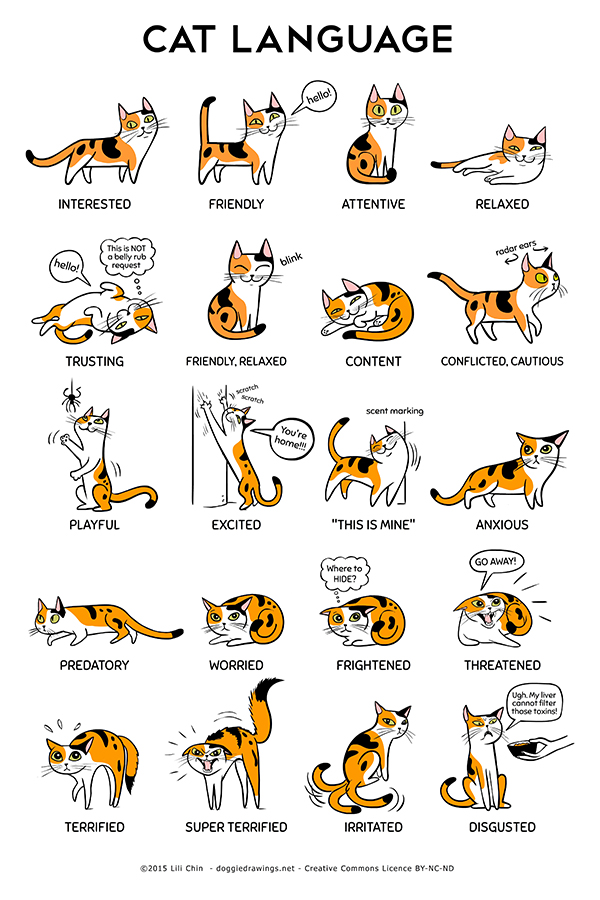 If you have an aggressive cat, life can get rough.
If you have an aggressive cat, life can get rough.
While aggression in cats is tough on you, it may be even tougher on your cat.
Identifying the root cause of the aggression and taking steps to alleviate the situation could lessen the aggressive behavior or eliminate it all together.
The first step to take when you notice aggression in your cat is to visit your veterinarian. There are many underlying medical issues that can cause aggression, including elevated thyroid levels and joint, muscle or stomach pain.
A veterinarian may take a blood sample, x-rays, an ultrasound, or run other tests to rule out any medical issues. Once those are ruled out, you can implement behavior modification strategies and start making environmental changes to see results.
The four most common types of cat aggression are: Fear-based aggression, play-related aggression, re-directed aggression, and territorial aggression.
Fear-Based Aggression
Fear-based aggression occurs when the cat responds aggressively to a perceived threat. This threat could include an environment that becomes loud or chaotic (i.e. you vacuum the house or invite friends over for karaoke). It can also come from being overwhelmed by you or a family member invading their space or picking them up when they don't want to be held. Or the perceived threat can be as simple as taking the cat for a car ride.
Tips for Aggressive Cats:
- The first step to take when you notice aggression in your cat is to visit your veterinarian.
- Once medical issues are ruled out, you can implement behavior modification strategies to see results.
- Many of the scenarios that would cause a cat to become aggressive can be alleviated by changes to the cat’s physical or social environment.
Play-Related Aggression
Play-related aggression occurs when the cat is engaging in play behavior, such as stalking and pouncing. This could be directed at people or other animals in the house, and, while the cat is not trying to hurt or threaten, he may in fact cause unintentional harm.
Re-Directed Aggression
Re-directed aggression occurs when the cat is hyper-aroused and then directs that arousal toward someone or something other than what stimulated the arousal. For example, if a cat is looking out the window and spots another cat outside in the yard, they may become agitated and start yowling. When someone comes up behind the cat in this state, the cat lashes out and it is perceived as an attack.
Territorial Aggression
Territorial aggression is directed toward other cats within the core territory, either inside or outside the physical home. This can develop when a new cat is introduced into the home, in response to a new cat moving into the neighborhood, or even after cats have been living together for years.

One of the most common situations that cause territorial aggression is space issues. For example, if there are three cats with access to one litter box and one food bowl, territorial aggression can develop due to perceived competition over access to those resources.
With any of the four types of aggression above, the first step to take is avoidance. If you can identify what is triggering the cat’s reaction, the best way to maintain immediate safety is to avoid the trigger.
Is the cat reacting aggressively when children approach or try to pick him up? Then make sure to carefully supervise all interactions with children or confine the cat to a bedroom when children are visiting. If the cat is reacting to his view outside a window, block the window. While this approach is in effect a band-aid – not fixing the problem, just avoiding it – it will help maintain safety until you can address the problem more deeply.
Next, educate yourself how to read your pet’s body language. Learn how to interpret vocalizations. You will learn whether your cat is asking you to play versus asking you to leave him alone. Learning how to communicate with your cat will make him more comfortable with you and will set the tone for next training steps.
Many of the scenarios that would cause a cat to become aggressive (not related to medical issues) can be alleviated by changes to the cat’s physical or social environment. Cats need environmental enrichment to stimulate their mind and engage their “wild side.” Check out PV kitty, Mazel, enjoying some environmental enrichment with his favorite wand toy.
Small changes, such as offering the cat new toys or setting up a cat tree, can cause significant improvements. Also, offering access to quiet areas to escape from stressful situations is imperative. To learn more, please read this article about environmental enrichment for cats.
A veterinary behaviorist can help you learn your cat’s body language, help you determine which type of aggression you are dealing with, and develop a treatment plan for you that will help alleviate the issues most efficiently. To find a veterinary behaviorist near you, visit the American College of Veterinary Behaviorists website.





